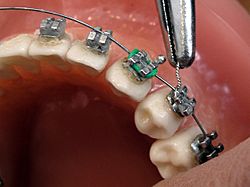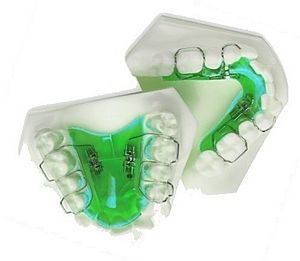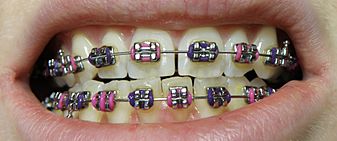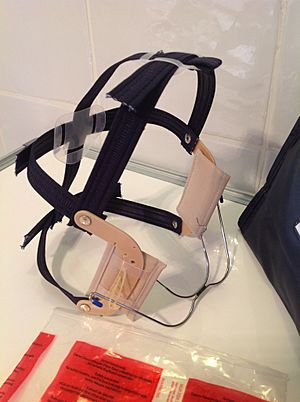Orthodontics facts for kids
 |
|
| Occupation | |
|---|---|
| Names | Orthodontist |
| Specialty | |
|
Activity sectors
|
Dentistry |
| Description | |
|
Education required
|
Dental degree, specialty training |
|
Fields of
employment |
Private practices, hospitals |
Orthodontics is a special part of dentistry. It focuses on fixing teeth and jaws that are not straight or don't fit together well. This includes diagnosing problems, preventing them, and correcting them. Sometimes, it also helps guide how the face grows, which is called dentofacial orthopedics.
Many people have teeth or jaws that aren't perfectly aligned. About half the people in developed countries could benefit from orthodontic treatment. However, only a small number truly need it for medical reasons. While there isn't strong scientific proof of health benefits, people who finish treatment often say their quality of life is better. Treatment can take months or even a few years. It usually involves dental braces and other tools to slowly move teeth and jaws into the right place. If the problem is very serious, jaw surgery might be part of the plan. It's often best to start treatment before you're fully grown, because young bones are easier to adjust.
Contents
How Orthodontics Started
People have had crooked teeth for a very long time. Even ancient Greeks and Etruscans (around 1000 BC) tried to fix them. They used simple but clever tools. In the 1700s and 1800s, dentists started describing and using devices to "regulate" teeth.
Orthodontics became a modern science in the mid-1800s. Two important people were Norman William Kingsley and Edward Angle. Angle created the first way to classify how teeth bite together, which dentists still use today.
Norman Kingsley wrote one of the first books about orthodontics. He was one of the first to use outside forces to fix teeth that stuck out. He also helped people with cleft palate. Back then, the main goal was to straighten teeth and make faces look nice. Dentists often removed teeth to fix crowding.
Later, in the late 1800s, Edward Angle became very important. He focused on how teeth fit together when you bite. He is known as the "father of modern orthodontics." By the early 1900s, orthodontics was about more than just straight teeth. It was about getting a perfect bite. Angle believed that having a full set of teeth and a perfect bite would also make your face look its best. He was against removing teeth.
But over time, dentists realized that even a perfect bite didn't always look good. Also, it was hard to keep teeth in that perfect bite position. So, in the 1940s and 1950s, dentists like Charles Tweed and Raymond Begg (who both studied with Angle) started removing teeth again. This helped improve how faces looked and made the bite more stable.
After World War II, orthodontists started using X-rays of the head. These X-rays showed that many bite problems came from jaw issues, not just crooked teeth. This led to new ways to treat jaws, like using special appliances or headgear. Today, these methods are used worldwide to change how jaws grow.
Around the 1970s, braces changed a lot. Before, metal was wrapped around each tooth. But with new adhesives, dentists could glue metal brackets directly onto the teeth.
In 1972, Lawrence F. Andrews described what a perfect bite should look like. Based on his ideas, he created the Straight-wire appliance system in 1976. This system made fixed braces much easier to use. Before this, orthodontists had to bend wires a lot to move teeth. The straight-wire system uses special brackets that already have the right angles built in, so less wire bending is needed.
Types of Orthodontic Appliances
Orthodontic appliances are tools used to move teeth. They come in two main types:
- Removable appliances: You can take these in and out yourself.
- Fixed appliances: These are glued to your teeth and stay on during treatment.
Fixed Appliances
Most modern fixed braces come from an idea called the "edgewise appliance." These braces usually start with round wires to begin straightening teeth. Then, rectangular wires are used for more precise tooth movement.
Edward Angle, an early orthodontist, created four main types of fixed appliances that influenced many of today's treatments:
- E-arch: This was an early device with a strong wire frame. Teeth were tied to it to create a better arch shape.
- Pin and Tube appliance: Angle used this to get more precise tooth movement. Small pins on the teeth fit into tubes, allowing for adjustments.
- Ribbon Arch: This was easier to use than the Pin and Tube. It had a special wire that was good at aligning crooked teeth. However, it wasn't great at controlling how the roots of the teeth moved.
- Edgewise Appliance: To fix the Ribbon Arch's problems, Angle changed the slot on the bracket to be horizontal. This allowed for better control over both the crown (top part) and root of the tooth. This appliance, introduced in 1928, became very popular.
Labiolingual Appliances
Before Angle, some dentists used removable devices with small springs to move teeth. Labiolingual appliances were also popular. They used bands on back teeth with strong wires and small springs to shift individual teeth.
Twin Wire Appliances
These appliances used two thin steel wires to align front teeth and molars. They were delicate and not very strong, so they aren't used much today.
Begg's Appliance
In the 1920s, Raymond Begg, an Australian orthodontist, improved on the ribbon arch appliance. He realized that sometimes teeth needed to be removed for the best results. He changed the ribbon arch to give more control over tooth roots.
In the late 1930s, Begg's appliance used a strong round stainless steel wire. It had a special bracket design and added small springs to control root movement. This design reduced friction, making tooth movement smoother.
Tip-Edge System
Modern brackets like Tip-Edge are influenced by Dr. Begg's ideas. They have a special slot that allows teeth to tip easily. This helps close spaces. Later, rectangular wires can be used to straighten the roots.
Modern Edgewise Systems
Today, edgewise appliances are very popular because they are efficient.
- Automatic Rotational Control: Early braces needed extra ties to control tooth rotations. Now, special brackets with "wings" or twin brackets help control rotations without extra ties.
- Custom Brackets: Instead of using the same bracket for every tooth, modern edgewise appliances have different brackets for each tooth. This helps reduce the need for the orthodontist to bend the wires a lot. Each bracket is designed to fit a specific tooth's shape and angle, making the treatment more precise.
How Orthodontic Treatment Works
A typical treatment for crooked teeth usually takes one to two years. Orthodontists, who are special dentists, adjust the braces every four to ten weeks. They offer many ways to straighten teeth, fix bites, and align jaws.
For kids and teens who are still growing, orthodontists can use special tools to guide jaw growth. These include functional appliances, orthodontic headgear, or a reverse pull facemask. Most orthodontic work starts before jaw growth is finished. If growth has stopped, jaw surgery might be an option. Sometimes, teeth are removed (often premolars) to make space for other teeth to move.
Most orthodontic treatment uses fixed appliances, like braces glued to the teeth. These give the orthodontist more control over tooth movement and often lead to better results. Fixed braces can rotate teeth, move them to new places, change their angle, or adjust their root position. However, they are not ideal if someone doesn't brush their teeth well, as it can lead to tooth decay. They also require commitment from the patient.
Braces
Braces are usually placed on the front of your teeth. Sometimes, they can be placed on the back, facing your tongue (these are called lingual braces). Brackets, made of stainless steel or porcelain, are glued to the center of your teeth. Wires are then placed into slots in these brackets. This allows the orthodontist to control how your teeth move in all directions.
Besides wires, orthodontists use elastic bands and springs to push teeth apart or close gaps. Several teeth can be tied together, and different hooks can be added to connect elastic bands.
Clear aligners are another option instead of braces. They are clear plastic trays that fit over your teeth.
How Long Does Treatment Take?
The time needed for braces is different for everyone. It depends on how severe the problem is, how much space is available, how far the teeth need to move, and how well you follow instructions. On average, braces stay on for one to three years. After braces are removed, most people need to wear a retainer. You usually wear it all the time for the first six months, then only during sleep for many years.
Headgear
Orthodontic headgear is a device that straps onto your head. It helps correct bite problems, especially when your teeth don't line up correctly. Headgear is often used with braces. While braces fix tooth positions, headgear helps change the alignment of your jaw. It can also help move molars.
Headgear works by pulling on your braces using hooks, a facebow, coils, or elastic bands. It's most effective for children and teenagers because their jaws are still growing and can be guided more easily. For adults, headgear is usually used to move teeth that have shifted after other teeth were removed. Headgear helps treat problems like overbite and underbite.
Palatal Expansion
Palatal expansion helps make your upper jaw wider. This is best done with a fixed appliance. Removable appliances can push teeth outwards, but they don't actually expand the jawbone as well. Proper jaw expansion can create more space for teeth and improve breathing through your mouth and nose.
Jaw Surgery
If bite problems are very severe, jaw surgery might be needed. During surgery, the jaw bone is carefully broken and then held in place with metal plates and screws while it heals. After surgery, regular orthodontic treatment helps move the teeth into their final positions.
During Treatment
Some people feel pain during orthodontic treatment. To help with this, methods like low-level laser therapy, vibrating devices, or special chewing tools can be used. However, there isn't strong proof that these methods always work.
After Treatment
After your orthodontic treatment is finished, your teeth might try to move back to where they were before. This is called "relapse." More than half of patients see some teeth move back within 10 years. To stop this, most patients get a retainer after their braces come off. Wearing your retainer is very important. Retainers can be fixed or removable.
Removable Retainers
Removable retainers are made of clear plastic and are custom-fitted to your mouth. They fit tightly and hold all your teeth in place. Examples include Zendura, Essix, and Vivera retainers. The Hawley retainer is another type, made of plastic and metal. You wear removable retainers for different amounts of time, depending on what your orthodontist recommends.
Fixed Retainers
Fixed retainers are a simple wire glued to the back of your front teeth (incisors). They are good at preventing these teeth from rotating. Other types of fixed retainers can also include braces with brackets glued to the teeth.
Clear Aligners
Clear aligners are another popular way to straighten teeth today. They are removable plastic trays, like Invisalign or Byte. Some people think they are faster and more comfortable than traditional braces.
Becoming an Orthodontist
Orthodontics was the first special area of dentistry to be officially recognized. The American Dental Association recognized it as a specialty in the 1950s. Each country has its own way of training and registering orthodontists.
To become an orthodontist, you first need to become a qualified dentist. This usually means completing a dental degree, like a DDS or DMD. After that, you need to complete special training in orthodontics. This extra training usually lasts for two to three years in a university program. It's very competitive to get into these programs.
After finishing the special training, orthodontists need to pass exams and register with their country's dental board to practice. This ensures they are experts in their field.
See also
 In Spanish: Ortodoncia para niños
In Spanish: Ortodoncia para niños
- Orthodontic technology
- Orthodontic indices
- List of orthodontic functional appliances
- Molar distalization
- Mouth breathing
- Obligate nasal breathing
Images for kids
-
An X-ray taken for skull analysis







